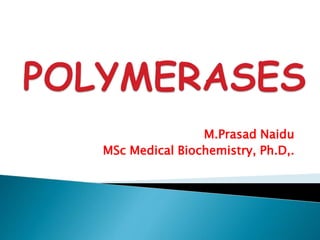
Polymerases,
- 1. M.Prasad Naidu MSc Medical Biochemistry, Ph.D,.
- 2. DNA-dependent DNA polymerases Eg. Prokaryotic and Eukaryotic DNA polymerases DNA-dependent RNA polymerases Eg. RNA polymerases and DNA primase RNA-dependent DNA polymerases Eg. Reverse transcriptase RNA-dependent RNA polymerases Eg. RNA replicase
- 3. Reich et al. showed the RNA synthesis even in the presence of actinomycin-D (that inhibits the DNA- primed RNA synthesis) Baltimore and Franklin showed the viral production with specific cytoplasmic fractions Thus, RNA-primed RNA synthesis was demonstrated This enzyme has been named RNA-dependent RNA polymerase or RNA Replicase
- 4. Structure of Qβ replicase: ◦ Four subunits 3 provided by E. coli host (Tu, Ts, and S1) 1 in viral RNA genome (MW 65,000) •Function: – Synthesis in 5’ to 3’ direction – Lacks proofreading function – Requires RNA template – Specific for RNA of the virus All RNA viruses (except retroviruses) encode a protein since the hosts do not possess it
- 5. RNA Replicase was isolated by Spiegelman et al. from Qβ bacteriophage This requires RNA template, Mg2+, rNTPs Qβ replicase is tetramer consisting of one Rep molecule and three host proteins Replicase copies viral (+) strand to generate a (-) strand
- 6. During synthesis, (-) strand is in contact with the (+) strand only at the polymerization site Initiation of several (-) strand occurs before the first (-) is complete, and the replicative form is branched The (-) strands are released and immediately used by the replicase to form (+) strands only
- 9. Temin and Baltimore (1970) independently demonstrated the presence of RT in several avian and mouse retroviruses RT is a RNA-dependent DNA polymerase It is used in rDNA technology to transcribe mRNA into dsDNA
- 10. RT has 3 enzymatic activities It copies an RNA molecule to yield dsDNA-RNA, using a primer and joining dNTPs in a 3’-5’ linkage It copies a primed ssDNA to form dsDNA It degrades RNA in a DNA-RNA hybrid; this is called RNase H activity (3’ to 5’ exoribonuclease activity)
- 13. (1) Viral genome and reverse transcriptase enter cell. Retrovirus - HIV
- 14. (1) Viral genome and reverse transcriptase enter cell. (2) DNA copy synthesized by reverse transcriptase. Site of action of AZT and other reverse Transcriptase inhibitors RNA DNA
- 15. (1) Viral genome and reverse transcriptase enter cell. (2) DNA copy synthesized by reverse transcriptase. Site of action of AZT and other reverse Transcriptase inhibitors RNA DNA (3) RNA degraded; second DNA strand synthesized. DNA DNA
- 16. (1) Viral genome and reverse transcriptase enter cell. (2) DNA copy synthesized by reverse transcriptase. (3) RNA degraded; second DNA strand synthesized. Host cell nucleus Host cell genome Site of action of AZT and other reverse Transcriptase inhibitors RNA DNA DNA DNA (4) DNA circularizes (unintegrated provirus) or integrase functions to incorporate DNA into host cell genome (integrated provirus). Site of action of antiretroviral drugs under development
- 17. (1) Viral genome and reverse transcriptase enter cell. (2) DNA copy synthesized by reverse transcriptase. (3) RNA degraded; second DNA strand synthesized. (5) With host cell activation, viral DNA is transcribed, yielding messenger RNAs and viral genome RNA. Host cell nucleus Host cell genome Site of action of AZT and other reverse Transcriptase inhibitors RNA DNA DNA DNA (4) DNA circularizes (unintegrated provirus) or integrase functions to incorporate DNA into host cell genome (integrated provirus). Site of action of antiretroviral drugs under development
- 18. (1) Viral genome and reverse transcriptase enter cell. (2) DNA copy synthesized by reverse transcriptase. (3) RNA degraded; second DNA strand synthesized. (5) With host cell activation, viral DNA is transcribed, yielding messenger RNAs and viral genome RNA. (6) Viral RNAs are translated, yielding viral enzymes (including protease) and structural proteins. Host cell nucleus Host cell genome Site of action of AZT and other reverse Transcriptase inhibitors Site of action of protease inhibitors RNA DNA DNA DNA (4) DNA circularizes (unintegrated provirus) or integrase functions to incorporate DNA into host cell genome (integrated provirus). Site of action of antiretroviral drugs under development
- 19. (1) Viral genome and reverse transcriptase enter cell. (2) DNA copy synthesized by reverse transcriptase. (3) RNA degraded; second DNA strand synthesized. (5) With host cell activation, viral DNA is transcribed, yielding messenger RNAs and viral genome RNA. (6) Viral RNAs are translated, yielding viral enzymes (including protease) and structural proteins. Host cell nucleus Host cell genome Site of action of AZT and other reverse Transcriptase inhibitors Site of action of protease inhibitors RNA DNA DNA DNA (7) Viral membrane proteins are transported to host cell membrane. (4) DNA circularizes (unintegrated provirus) or integrase functions to incorporate DNA into host cell genome (integrated provirus). Site of action of antiretroviral drugs under development
- 20. (1) Viral genome and reverse transcriptase enter cell. (2) DNA copy synthesized by reverse transcriptase. (3) RNA degraded; second DNA strand synthesized. (8) Final viral assembly and budding take place. (5) With host cell activation, viral DNA is transcribed, yielding messenger RNAs and viral genome RNA. (6) Viral RNAs are translated, yielding viral enzymes (including protease) and structural proteins. Host cell nucleus Host cell genome Site of action of AZT and other reverse Transcriptase inhibitors Site of action of protease inhibitors RNA DNA DNA DNA (7) Viral membrane proteins are transported to host cell membrane. (4) DNA circularizes (unintegrated provirus) or integrase functions to incorporate DNA into host cell genome (integrated provirus). Site of action of antiretroviral drugs under development
